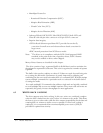
Maxtor Atlas 10K V 6-5
information about the reallocation (such as the new destination and the data in transit)
is recorded. If the reallocation is interrupted, the process can automatically continue
from the last checkpoint without data loss.
If a block reallocation is performed on unrecoverable data (rare), a Bad Data Mark is
set in the new location. Thus, there is no chance of undetected bad data being
generated from a reallocation.
6.8.5 Data Verification
Data can be verified in two ways. First, the integrity of data in selected areas of the
media can be checked using the VERIFY command. Secondly, the WRITE AND
VERIFY command writes host-supplied data and then verifies that it was written
correctly.
The Verify Error Recovery Page of the MODE SELECT COMMAND controls the
drive's response to error conditions that arise during the VERIFY command and
during the verify operation of the WRITE AND VERIFY command.
6.9 TAGGED COMMAND QUEUING
The drive supports all three SCSI-defined queue tag messages. When queuing is
enabled (default condition), the drive can accept any of the following:
• Simple - specifies that the command is to be placed in the drive's
command task set (queue). If several commands are present, the drive
may reorder them to increase overall throughput.
• Head of Queue - directs the drive to place the command at the
beginning of the queue, to be executed next. Consecutive commands
with Head of Queue specified are executed in last-in-first-out (LIFO)
order. Queue depth is 64.
• Ordered - specifies that commands in the drive's task set are to be
executed in the order received (FIFO).
The DQue bit (disable queuing) of the Control Mode page can be used to disable
tagged command queuing.
6.10 COMMAND REORDERING
The drive uses Optimized Reordering Command Algorithm (ORCA) and tagged
command queuing to provide greater throughput by reordering any commands
queued on the drive to minimize rotational latency, seek time and head selection time.
6.11 BANDED RECORDING
In banded recording, the disk is divided into multiple bands (also called partitions,
notches, or bit-zoned areas). Starting at the inner band, each band further out has
more blocks per track (a higher recording frequency). This use of multiple-frequency
recording increases the capacity of the drive.


















